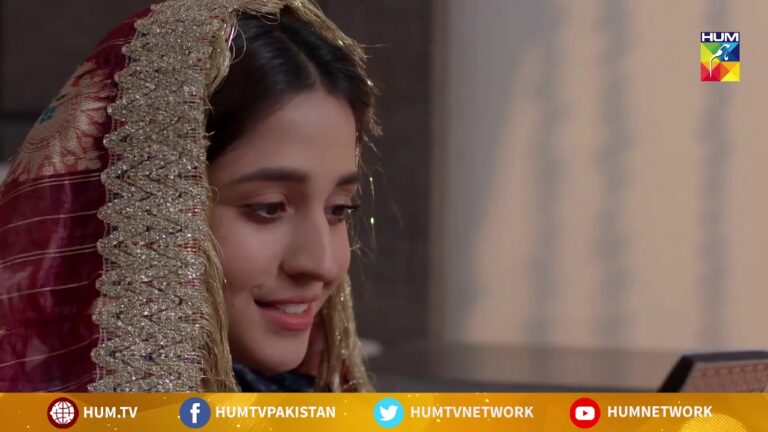Sabaat Drama Review: Sabaat (Urdu: صبر, lit. ”Patience”) is a 2017 Pakistani drama serial that captivated audiences with its blend of romance, social commentary, and the compelling journey of its protagonist, Miraal (Mawra Hocane). This review explores the drama’s strengths and weaknesses, offering a comprehensive analysis of its impact on viewers.
A Story of Unfulfilled Dreams and Second Chances:
The narrative revolves around Miraal, a young woman from a middle-class family with aspirations of becoming a doctor. However, societal pressures and family obligations force her to abandon her dreams and marry Danish (Zahid Ahmed), a successful businessman. Despite initial hesitation, Miraal finds comfort and support in Danish, who encourages her to pursue her education later.
However, tragedy strikes as Danish dies in an accident soon after their marriage. Devastated and alone, Miraal is further burdened by societal expectations and family pressure to remarry. Yet, she finds solace in her studies and eventually fulfills her childhood dream of becoming a doctor. Through her perseverance and resilience, Miraal embarks on a journey of self-discovery, defying societal norms and achieving personal fulfillment.
Strengths of the Drama:
-
Compelling Characters: The characters are the foundation of Sabaat’s success. Miraal, a determined and strong-willed woman, resonates with viewers due to her struggles and triumphs. Her journey of overcoming societal pressures and pursuing her dreams is both inspiring and relatable. The supporting characters, including Danish, Miraal’s family, and her friends, add depth and complexity to the narrative, showcasing diverse perspectives and societal influences.
-
Powerful Social Commentary: Sabaat subtly addresses several social issues prevalent in Pakistani society. The drama sheds light on the societal pressure placed on women regarding marriage and career choices. It also highlights the challenges faced by widows and the importance of empowering women to pursue their dreams and achieve independence.
-
Beautifully Crafted Narrative: The drama unfolds at a well-paced and engrossing tempo. The narrative seamlessly blends moments of joy, heartbreak, and triumph, keeping viewers engaged throughout the story. The use of flashbacks effectively portrays Miraal’s past and adds depth to her character development.
-
Emotional Connection: Sabaat evokes a strong emotional response from viewers. Miraal’s struggles resonate with individuals who have faced societal pressures or personal loss. The drama celebrates the power of perseverance and the importance of pursuing dreams, offering a message of hope and encouragement.
Weaknesses of the Drama:
-
Predictable Plot Twists: While the overall narrative is engaging, some plot twists might appear predictable to seasoned viewers of Pakistani dramas. Certain recurring tropes, such as misunderstandings and societal pressure used as conflict-driving elements, might feel slightly repetitive.
-
Portrayal of Antagonists: The portrayal of certain antagonistic characters, particularly Miraal’s relatives who oppose her education and independence, can appear one-dimensional at times. This might limit the complexity of the narrative and the audience’s understanding of their motivations.
Delving Deeper into Sabaat: Exploring Symbolism and Character Nuances
Building upon the initial review, let’s delve deeper into specific aspects of Sabaat:
Exploring Symbolism and Artistic Choices:
Sabaat utilizes various symbolic elements to enhance the narrative’s depth and emotional impact. The recurring motif of books and education represents Miraal’s aspirations and her unwavering determination to achieve them. Throughout the drama, books are shown as her source of solace and strength, highlighting the transformative power of knowledge and education in her life.
The use of contrasting colors is employed effectively. Miraal’s vibrant clothing choices, particularly when pursuing her studies, symbolize her newfound freedom and self-expression. In contrast, the muted tones used in scenes depicting societal pressures and limitations visually represent the constraints she faces.
The director utilizes close-up shots to capture the emotional nuances of the characters, allowing viewers to connect with their internal struggles and triumphs. Slow-motion sequences are used effectively during pivotal moments, emphasizing the emotional weight of the scene and allowing viewers to fully absorb the characters’ emotions.
Beyond the Romance: Exploring Family Dynamics and Societal Pressures:
While the narrative revolves around Miraal’s love story with Danish and her journey of self-discovery, Sabaat also delves into the complexities of family dynamics and societal pressures. The portrayal of Miraal’s family, particularly her relatives who oppose her education, is not solely antagonistic. The drama subtly explores the underlying societal norms and economic realities that shape their perspectives, offering a nuanced understanding of their motivations.
Danish’s character serves as a catalyst for Miraal’s growth. His unwavering support and encouragement empower her to pursue her dreams. However, the drama avoids glorifying him as a perfect character, showcasing his limitations and vulnerabilities. This multifaceted portrayal adds depth and realism to their relationship.
Beyond the Screen: Legacy and Social Impact:
Sabaat’s legacy extends beyond its entertainment value. The drama sparked important conversations about women’s education, societal expectations, and the importance of female empowerment. It challenged viewers to question traditional narratives that limit women’s choices and highlighted the need for creating opportunities and fostering support systems for women to pursue their aspirations.
Furthermore, the drama resonated with a global audience by offering a relatable narrative of overcoming adversity and pursuing personal dreams. Miraal’s journey serves as an inspiration for individuals facing societal pressures or personal challenges, offering a message of hope and encouragement to persevere and achieve self-fulfillment.
Overall Impact:
Despite its minor shortcomings, Sabaat remains a compelling and impactful drama. Its exploration of social issues, relatable characters, and powerful narrative leave a lasting impression on viewers. The drama encourages viewers to challenge societal norms, embrace personal aspirations, and celebrate the power of resilience in the face of adversity.
Beyond the Screen: Legacy and Social Discourse:
Sabaat sparked important conversations about the portrayal of women in Pakistani society and the importance of female education and empowerment. The drama challenged traditional narratives that limit women’s choices and highlighted the need for support and encouragement for women striving to achieve their goals.
Furthermore, the drama resonated with a global audience. The themes of resilience, pursuing dreams, and overcoming societal pressures transcend cultural boundaries and offered a relatable narrative for viewers from various backgrounds.
Conclusion:
Sabaat, with its strengths and weaknesses, offers a captivating and thought-provoking viewing experience. The exploration of social issues, relatable characters, and the inspiring journey of self-discovery are central to the drama’s lasting impact. While certain elements might appear predictable or lack nuance, the overall narrative encourages viewers to reflect on societal expectations, explore personal aspirations, and celebrate the transformative power of perseverance and self-belief.
By incorporating specific examples from the drama and further details about your personal interpretation, you can personalize this review and create a more unique and engaging analysis.










+ There are no comments
Add yours